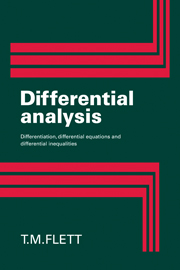Summary
The title Differential Analysis indicates clearly the content of this book. It is concerned with those parts of analysis in which the idea of differentiation, derivative or differential plays a central role. It is true that the functions to be discussed all take values in normed spaces and, for a large part of the book, they also have subsets of normed spaces as domains, but the basic aim is the generalization and subsequent application of the fundamental theorems of the differential calculus of functions of one real variable.
To be sure, this generalization, simple as it is in essence, extends the range of applications widely. One differential equation involving functions of one variable but with values in a normed space can be equivalent to an infinite system of equations involving scalar-valued functions. The calculus of variations becomes a part of the ‘ordinary’ theory of maxima and minima. Very general questions about constrained maxima and minima become problems about inclusions between tangent spaces. When set in Banach space, the Newton method, giving an iterative procedure for finding (approximate) solutions of equations, becomes applicable to integral and differential equations.
Although the theory has such a wide import, it remains basically elementary. The reader who glances through the appendix (listing results required in the text) will disbelieve this assertion: some deep theorems are given there. This is indeed true, but except in one or two sections, appeals to these results are rare.
- Type
- Chapter
- Information
- Differential AnalysisDifferentiation, Differential Equations and Differential Inequalities, pp. 1 - 2Publisher: Cambridge University PressPrint publication year: 1980

